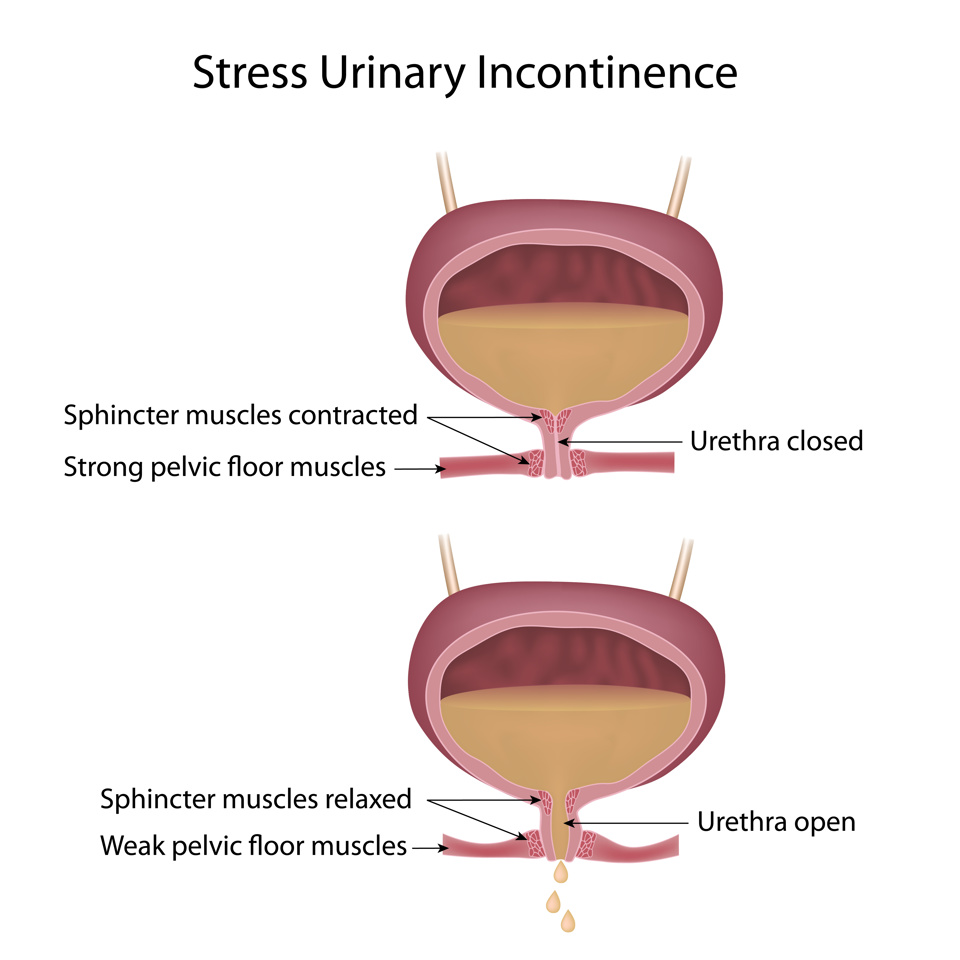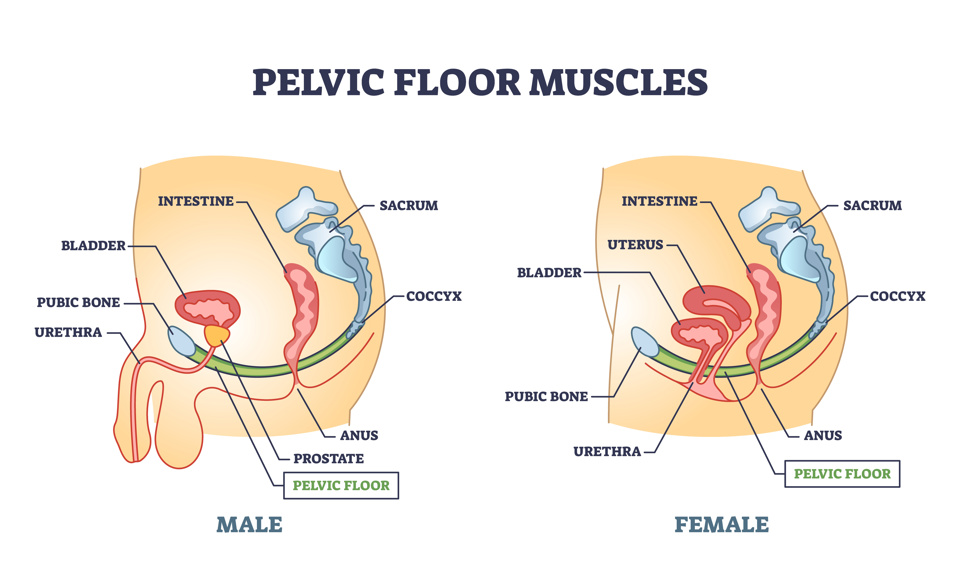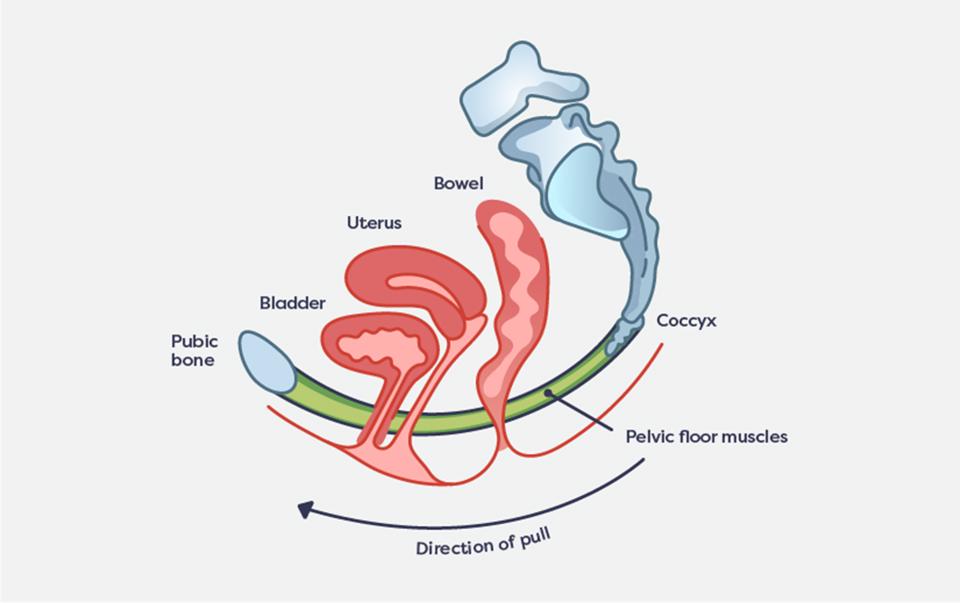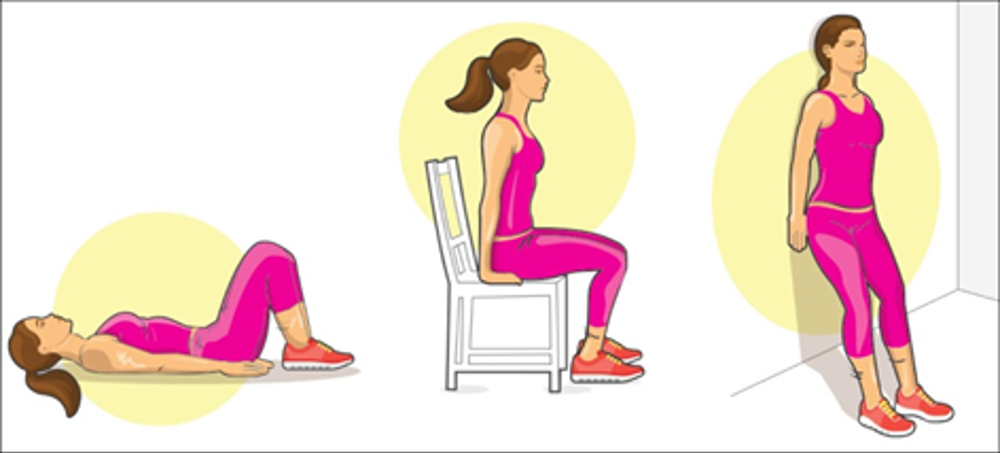What is stress urinary incontinence?
This is when physical stress on the bladder causes you to leak urine. This can happen for example, when you cough, sneeze, get up from a chair, run, lift something, laugh or during sexual intercourse.
Stress urinary incontinence (SUI) is not linked to feeling stressed. Physical exercise, strain or movement causes extra pressure on the abdomen/tummy. This puts pressure on the bladder. If the muscles which support and close off the bladder’s opening – the pelvic floor muscles, do not work properly during these activities, urine can leak out.
The problem is more common in women, but men can suffer from it too. It is very common; up to 1 in 3 people will experience urine leakage at some point.

Why do the muscles not work properly?
The muscles that support, and close off the bladder are called the pelvic floor muscles. Sometimes they can become weak. The most common cause for this is pregnancy and childbirth. Being overweight, smoking, having a bad cough, constipation, lack of general fitness, menopausal changes and having had surgery in the pelvis can also weaken the muscles.
Side view of a male (left) and female’s (right) pelvic floor muscles

What can I do about it?
- Working on the pelvic floor exercises regularly is one of the most important things you can do. The information and videos below will help you to understand how to do this and how long to exercise for.
- Whenever there is an increase in pressure on your bladder, such as when you cough or lift something, you should pull up with your pelvic floor muscles. This is known as “The Knack”.
- Nicotine weakens the contraction of pelvic floor muscles. Chronic coughing as a result of smoking increases stress incontinence. If you are a smoker, you may want to consider giving up or even cutting down.
- If you are overweight, losing a few pounds can help to reduce the pressure placed on the pelvic floor muscles.
- General exercise to strengthen the muscles around the hips and lower back can help improve the function of the pelvic floor muscles. Gradually increasing your activity through walking is a good place to start.
- If you have had a cough for a long time, or are constipated, you should get advice or treatment from your doctor or pharmacist for these problems.
Pelvic floor exercises
The pelvic floor muscles are at the bottom of the pelvis, between your legs. They are attached between the tail bone (coccyx) at the back and the bone at the front of your pelvis (pubic bone). They help to support the pelvic organs such as the bladder, the womb (if you have one) and the bowel. These muscles work to help to keep the bladder and bowel openings closed and they relax when you empty your bladder or bowels.
Pelvic floor muscles should be worked regularly to keep them healthy and strong like other muscles in your body. They can become weak if they are not used regularly or if they are put under a lot of strain.
To work these muscles, you should gently tighten around your anus (back passage) as if you are trying to stop passing wind. At the same time, try to gently tighten as if you were trying to stop passing urine mid-flow. You should be pulling upwards and forwards from your back passage towards your bladder.
You might find it easier to do them lying on your back with your knees bent up or sitting. You do not need to lie on the floor; you can lie comfortably on a bed or sofa. It is easy to use the wrong muscles instead of the pelvic floor, try not to squeeze your buttocks, thighs, or tummy. Keep breathing throughout with a soft, relaxed lower belly.


Pelvic Floor Muscles Explained - YouTube
Follow the QR link to the side to watch a video explaining more about how to use your pelvic floor muscles.

How do you find your pelvic floor? | Squeezy | Jilly Bond - YouTube
Follow the QR link to the side to watch a video explaining more about how to find your pelvic floor muscles.
Slow Holds
- Close the back passage, gently pull forwards and up, towards your bladder.
- Hold for as long as you can – up to 10 seconds, without holding your breath, squeezing your legs or bottom, or sucking your tummy in.
- Then, fully relax – let the muscles drop back to the tail bone, and let the back passage relax.
- Rest and breathe quietly with a soft belly for a few seconds before repeating.
- Repeat this exercise up to 10 times. You should feel the muscles are a little tired when you stop. Try this now:
How long can you hold for? ……….. Seconds
How many of these can you repeat? ……… times
Fast Squeezes
- Tighten the same pelvic floor muscles quickly and firmly, hold for 1 second.
- Try to focus on only using your pelvic floor- not sucking in your belly or holding your breath. If this happens, try to be a little more gentle.
- Take time to fully relax the muscle before repeating the exercise.
- Repeat this up to 10 times. You should keep repeating until your muscles are a little tired. Try this now:
How many of these can you repeat with good technique? ……… times
You should practice both fast and slow exercises 3 times a day. You can work the muscles in different positions. These include lying on your back with your knees bent up, sitting upright on a firm chair, or standing.

Progressing
To see further improvement with muscle strength, you need to continually progress your exercises of a number of weeks. To do this slowly build up how long you can hold the squeeze for, and how many you can do in a row – try to add on a second or a repetition each week.
Once you can hold for 10 seconds x10 repetitions and 10 fast squeezes – start trying to do the exercises standing up.
You might need to spend a few weeks gradually building up again, aiming eventually to be able to easily hold for 10 seconds x 10 repetitions, and do 10 fast squeezes standing up.
It takes 3-5 months of daily practice to build up good muscle strength, but you should see your symptoms slowly getting better before this.
Please see our NHS Fife Pelvic Floor Exercises leaflets (stage 1-3) for more help with progressions.
Warning!
Although stopping your urine midstream does work your pelvic floor, this should not be done on a regular basis. It may interfere with normal bladder function.
If you get any pain, or your symptoms worsen after doing these exercises, firstly try not to squeeze as hard and take longer rest between each squeeze. If this does not help seek help from a specialist physiotherapist. You can be referred by your GP or specialist Doctor.

Squeezy app

12 week weight management

Constipation management

Stopping smoking

Health and wellbeing
Other ways to help
Squeezy App
“Squeezy” is the NHS App for pelvic floor muscle exercises and is available from the App Store and Google Play. This app has been designed by physiotherapists working in the NHS. It can give you reminders to exercise. It can display how long you should hold and how many to do. You can adjust these numbers in the “Exercise Plan”. To access the exercise program click on “Squeeze Now”. There are also other pelvic floor exercise apps freely available.
What Next?
80% of people with stress incontinence will get better by reducing pressure on their pelvic floor muscles with:
- Pelvic floor exercises
- Gentle weight loss
12 Week Weight Management Programme | NHS inform
- Constipation management
Constipation - Illnesses & conditions | NHS inform
- Stop smoking
Stop smoking service | NHS Fife
- Gentle full body exercise
If you do not improve
If you do not improve speak to your GP, other options can include:
Medication
There is medication available which may be prescribed by your doctor to help with stress incontinence. This is not seen as the best way to treat stress incontinence as it has side effects and isn’t always effective. Discuss these with your GP if you are interested.
Vaginal Devices for Stress Incontinence
Your GP, Urogyanecology specialist or physiotherapist may be able to recommend products which can be used vaginally to support the opening of the bladder. These can be useful if you leak with specific activities such as at the gym or running.
Surgery
Your GP can refer you to specialist Doctors, who can discuss any possible surgical options with you.
Further information
www.nhs.uk/conditions/urinary-incontinence
https://pogp.csp.org.uk/publications/pelvic-floor-muscle-exercises-women
Accessible formats
If you require this information in a community language or alternative format such as Braille, audio, large print, BSL, or Easy Read, please contact the Equality and Human Rights Team at: email: fife.EqualityandHumanRights@nhs.scot or phone 01592 729130. For people with a hearing or verbal impairment you can also contact the team through the NHS Fife SMS text service number on 07805800005.
